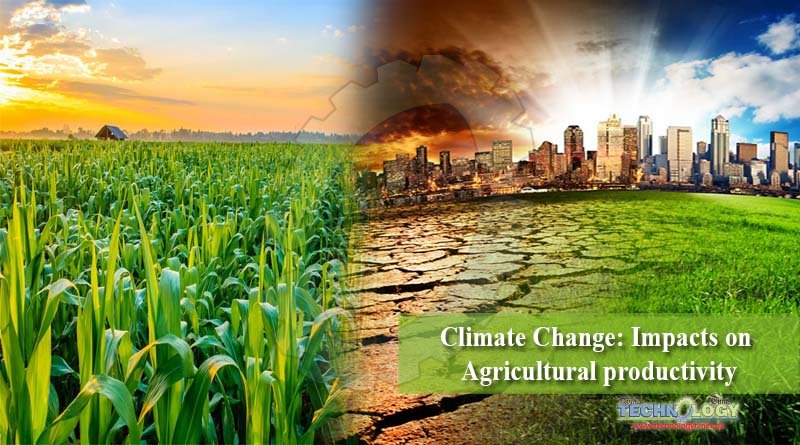In future scenario, food security will be an issue of prime importance under world growing population pressure. With increasing the world population, the demands for food is increasing day by day. To meet this basic demand of the food, here is the need to increase the productivity of crops. Under the phenomenon of climate change, the agricultural is adversely affecting with rise in temperature and fluctuations in the precipitation.
 Agriculture sector is a backbone in Pakistan economy. Its share in GDP (Gross Domestic Product) is 18.5%. Pakistan falls at position 8th among all those countries which are severely affecting by the impact of climate change.
Agriculture sector is a backbone in Pakistan economy. Its share in GDP (Gross Domestic Product) is 18.5%. Pakistan falls at position 8th among all those countries which are severely affecting by the impact of climate change.
Climate and Agriculture are interdependent in different aspects. Variations in climate are major sources of stresses in plants may be biotic and abiotic. These stresses are adversely affecting the agricultural productivity of different regions. The agricultural crops and the lands are affecting by climate change in different ways e.g., un uniformly distribution of rain fall, high atmospheric temperature, low relative humidity, hot dry winds, high atmosphere water demand (potential Evapotranspiration).
Vagaries of monsoon (late onset or early withdrawal of monsoon), modification in weed species, insect, pest and micro-organism population and their activity decline crop yield. A change in atmospheric carbon dioxide and ozone levels also harms the plants and animals.
Impact on crops: Climate change promotes vulnerabilities for water resources, forests and agriculture on which a large portion of livelihoods and economy of a country depends. Increase in global temperature induces a lot of changes in agriculture sector.
Shortening of growing seasons by early maturation, altering the different species patterns, promoting moisture stress by increasing evaporation losses, changing the properties of soil are due to rise in temperature. High temperature enhances decomposition of organic matter and reduces soil fertility, increase the exposure of insects, pests and disease and hence ultimately decrease the productivity of crops.
Climate change impact varies according to the agro ecological zones. It can induce de-glaciations and affecting on our water resources that play a critical role in energy production. Fluctuations in precipitation and melting of glaciers are a source of flooding which wipe out large area standing crops and promote water erosion.
Frequency of forest fire is directly related with heat. Crop growth, development and ultimately yield is severely affected by abiotic stresses. Under some natural climatic conditions the crops are exposed to salinity, water logging, cold, heat and drought conditions. In 21st century the two major problems for the world population are climate change and food insecurity. Increase in temperature is contributing a lot in reduction of the yield of major food crop around the world.
According to an estimate, the wheat yield is reduced 6% by each oC rise in temperature. Cereals yield is mostly affecting by high temperature and drought stress. The most critical enzyme in photosynthesis process Rubisco is disrupted when temperature reaches above 35oC and photosynthetic activity is stopped. Due to climate change phenomenon, increase in temperature cause water deficit which ultimately affects the flower initiation and inflorescence of the cereals plants.
When the atmospheric temperature increases of about 30oC during development of florets it can cause sterile condition in cereals. 35-70% grain set and 60% harvest index is reduced due to moisture deficit. Adaptation of crops has been suffered not only due to sudden rise in atmospheric temperature but also due to fluctuation in rainfall pattern.
Impact on livestock:
Livestock productivity is also affecting by the climate change especially with increase in temperature. It imposes physiological stress on animals; hence milk and meat productivity is badly affected. This phenomenon has very adverse affects on the conception and reproduction of the livestock. Climate change (Increase in temperature and fluctuations in precipitation) reduces the productivity of agricultural and badly affect the quality and stability of forage, hence increase the demand of water for both crops and animals.
The direct effect of climate change especially increases in temperature on livestock is increase the potential for morbidity and death. The indirect affect is in the form of incidence of pathogens or parasites, food- borne diseases, water and feed scarcity, host resistance and vector-borne diseases.
Impact on fisheries:
At higher altitude, fisheries are badly affected with low availability of oxygen due to sudden increase in surface air temperature. In plain areas, fluctuation in precipitation could promote the migration of fish species toward flood plains from river for growth, dispersal and spawning. Future changes in sea water temperature, ocean currents and wind speed and direction may change the fish breeding habitat, supply of food and may affect the abundance of fish population. All these problems due to climate change are a hurdle in food security.
Cause of climate change:
Green house gases (CO2, Methane, and N20) are contributing a lot in climate change. Anthropogenic activities like burning of fossils fuel, deforestation, methane emission from rice field etc contributing a major part in the climate change.
Solution:
To overcome this issue we have to reduce the emission of these gases to minimize the effects of climate change on agricultural and various other ecosystems to ensure food security.
